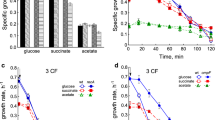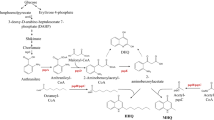Abstract
This study demonstrated the role of cadaverine in the adaptation of Escherichia coli to hydrogen peroxide. A dose-dependent increase in the expression of the ldcC and cadA genes that encode cadaverine-synthesizing enzymes was shown in cells exposed to exogenous hydrogen peroxide. An inverse relationship between bacterial sensitivity and the level of intracellular cadaverine at the time of hydrogen peroxide addition was found. Sensitivity to hydrogen peroxide also depended on the ability to synthesize cadaverine (via the ldcC and cadA genes). In particular, the death rate of cells that are incapable of synthesizing cadaverine was higher compared to cadaverine-producing cells. Sensitivity to hydrogen peroxide increased in a series of isogenic strains with the genotype: wild type < ΔcadA < ΔldcC < ΔldcCΔcadA. The role of the accumulation of reactive oxygen species, including hydrogen peroxide, in the activation of the ldcC and cadA genes in cells exposed to the antibiotic levofloxacin was also shown.




Similar content being viewed by others
REFERENCES
Linley, E., Denyer, S.P., McDonnell, G., Simons, C., and Maillard, J.Y., J. Antimicrob. Chemother., 2012, vol. 67, no. 7, pp. 1589–1596.
McEvoy, B. and Rowan, N.J., J. Appl. Microbiol., 2019, vol. 127, no. 5, pp. 1403–1420.
McDonnell, G. and Russell, A.D., Clin. Microbiol. Rev., 1999, vol. 12, no. 1, pp. 147–179.
Fichet, G., Antloga, K., Comoy, E., Deslys, J.P., and McDonnell, G., J. Hosp. Infect., 2007, vol. 67, no. 3, pp. 278–286.
Kislenko, V.N. and Berlin, A.A., Russ. Chem. Rev., 1991, vol. 60, no. 5, pp. 470–488.
González-Flecha, B. and Demple, B., J. Biol. Chem., 1995, vol. 70, no. 23, pp. 13681–13687.
Mols, M. and Abee, T., Environ. Microbiol., 2011, vol. 13, no. 6, pp. 1387.
Akhova, A.V., Sekatskaya, P.A., and Tkachenko, A.G., Appl. Biochem. Microbiol, 2019, vol. 55, pp. 582–587.
Gu, M. and Imlay, J.A., Mol. Microbiol., 2011, vol. 79, no. 5, pp. 1136–1150.
Imlay, J.A., Environ. Microbiol., 2019, vol. 21, no. 2, pp. 521–530.
Khmelevtsova, L.E., Sazykin, I.S., Azhogina, T.N., and Sazykina, M.A., Appl. Biochem. Microbiol., 2020, vol. 56, no. 4, pp. 373–380.
Sen, A. and Imlay, J.A., Front. Immunol., 2021, vol. 12, article ID 667343.
Tkachenko, A.G. and Nesterova, L.Y., Biochemistry (Moscow), 2003, vol. 68, no. 8, pp. 850–856.
Chattopadhyay, M.K., Tabor, C.W., and Tabor, H., Proc. Natl. Acad. Sci. U. S. A., 2003, vol. 100, no. 5, pp. 2261–2265.
Akhova, A., Nesterova, L., Shumkov, M., and Tkachenko, A., Res. Microbiol., 2021, vol. 172, no. 7, article ID 103881.
Miller, J.H., Experiments in Molecular Genetics, New York: Cold Spring Harbor Laboratory, 1972.
Performance Standards for Antimicrobial Susceptibility Testing, CLSI Document M100-S24, Wayne, PA: Clinical and Laboratory Standards Institute, 2014, 30th ed., vol. 40, no. 1.
Kikuchi, Y., Kurahashi, O., Nagano, T., and Kamio, Y., Biosci. Biotechnol. Biochem., 1998, vol. 62, no. 6, pp. 1267–1270.
Wascher, T.C., Posch, K., Wallner, S., Hermetter, A., Kostner, G.M., and Graier, W.F., Biochem. Biophys. Res. Commun., 1997, vol. 234, no. 1, pp. 35–38.
Olin-Sandoval, V., Yu, J.S.L., Miller-Fleming, L., Alam, M.T., Kamrad, S., Correia-Melo, C., et al., Nature, 2019, vol. 572, pp. 249–253.
Godoy, M.S., Nikel, P.I., Cabrera Gomez, J.G., and Pettinari, M.J., Appl. Environ. Microbiol., 2015, vol. 82, no. 1, pp. 244–254.
Kohanski, M.A., Dwyer, D.J., Hayete, B., Lawrence, C.A., and Collins, J.J., Cell, 2007, vol. 130, no. 5, pp. 797–810.
Akhova, A.V. and Tkachenko, A.G., FEMS Microbiol. Lett., 2014, vol. 353, no. 1, pp. 69–76.
Randall, L.O., J. Biol. Chem., 1946, vol. 164, pp. 521–527.
Anbar, M. and Neta, P., Int. J. Appl. Radiat. Isot., 1967, vol. 18, pp. 493–523.
Gaboriau, F., Vaultier, M., Moulinoux, J., and Delcros, J., Redox Rep., vol. 10, pp. 9–18.
Spirin, A. and Gavrilova, L., The Ribosome, New York: Springer-Verlag, 1969.
Kojima, S., Kaneko, J., Abe, N., Takatsuka, Y., and Kamio, Y., J. Bacteriol., 2011, vol. 193, pp. 2347–2350. https://doi.org/10.1128/JB.00106-11
Akhova, A.V. and Tkachenko, A.G., Korean J. Microbiol., 2020, vol. 56, pp. 103–110.
ACKNOWLEDGMENTS
The authors express their sincere gratitude to Professor Bruce Demple (Stony Brook University Medical School, Stony Brook, NY) for providing the E. coli strain.
Funding
The work was supported by the Ministry of Science and Higher Education of the Russian Federation (АААА-А19-119112290009-1).
Author information
Authors and Affiliations
Corresponding author
Ethics declarations
The authors declare they have no conflicts of interest. The studies were conducted without the use of animals and without involving people as subjects.
Rights and permissions
About this article
Cite this article
Akhova, A.V., Tkachenko, A.G. Cadaverine Biosynthesis in Escherichia сoli Adaptation to Hydrogen Peroxide. Appl Biochem Microbiol 58, 582–589 (2022). https://doi.org/10.1134/S0003683822050039
Received:
Revised:
Accepted:
Published:
Issue Date:
DOI: https://doi.org/10.1134/S0003683822050039




